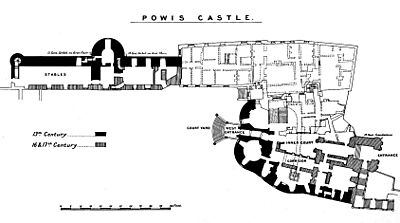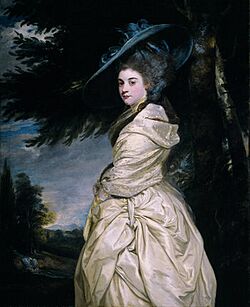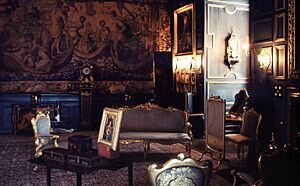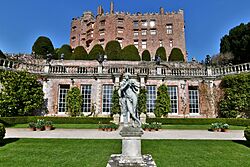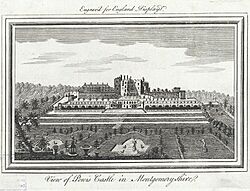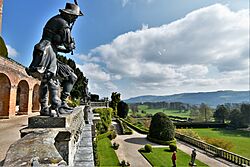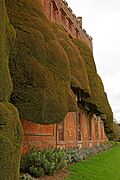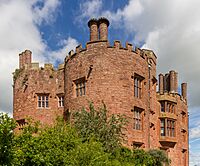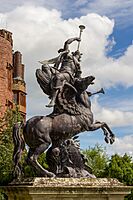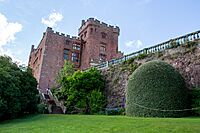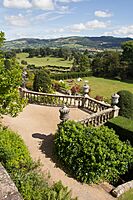Powis Castle facts for kids
Quick facts for kids Powis Castle |
|
|---|---|
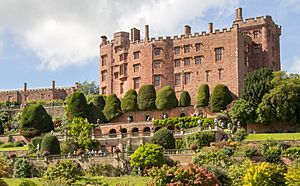
Powis Castle from the south, showing the distinctive terraced gardens
|
|
| Type | Castle |
| Location | Welshpool, Powys, Wales |
| Architect | William Winde, Robert Smirke, George Frederick Bodley |
| Owner | National Trust |
| Official name: Powis Castle | |
| Designated | 1 February 2022 |
| Reference no. | PGW(Po)35(POW) |
| Listing | Grade I |
|
Listed Building – Grade I
|
|
| Official name: Powis Castle | |
| Designated | 25 April 1950 |
| Reference no. | 7746 |
|
Listed Building – Grade I
|
|
| Official name: Aviary Terrace in Powis Castle Gardens | |
| Designated | 11 March 1981 |
| Reference no. | 16775 |
|
Listed Building – Grade I
|
|
| Official name: Orangery Terrace in Gardens at Powis Castle | |
| Designated | 11 March 1981 |
| Reference no. | 16776 |
|
Listed Building – Grade I
|
|
| Official name: Apple Slope Terrace in Gardens at Powis Castle | |
| Designated | 11 March 1981 |
| Reference no. | 16777 |
| Lua error in Module:Location_map at line 420: attempt to index field 'wikibase' (a nil value). | |
Powis Castle (Welsh: Castell Powys) is an amazing old castle and grand country house in Welshpool, Powys, Wales. It's famous for its beautiful terraced gardens and stunning rooms. Many people say its gardens are "the most important" and its interiors are "the most magnificent" in the country. Today, the National Trust looks after both the castle and its gardens. Powis Castle is a very important historical building, known as a Grade I listed building. Its gardens also have a special Grade I listing.
The castle you see today was built in the 13th century. What's cool is that a Welsh prince, Gruffydd ap Gwenwynwyn, built it. This was unusual because most castles in this area were built by English barons. Gruffydd was the prince of the ancient Kingdom of Powys. He worked with the English king Edward I during the wars of the late 1200s. This helped his son, Owain, keep his position, even though the kingdom itself was later changed.
Later, in the late 1500s, the Herbert family bought the castle. They have been connected to Powis Castle ever since! The Herberts were Catholic for a long time. This caused them some trouble, including being imprisoned or sent away from the country. But they still managed to turn Powis from a strong border fortress into a fancy country house. They also created one of Britain's few remaining Baroque gardens.
In 1784, Henrietta Herbert married Edward Clive. This marriage brought a lot of money to the Herbert family. In the early 1900s, George Herbert, 4th Earl of Powis, updated the castle with help from architect George Frederick Bodley. His wife, Violet, worked hard on the garden. She wanted it to be "one of the most beautiful" in England and Wales. After the 4th Earl died in 1952, the castle was given to the National Trust.
History of Powis Castle
Early Castles in Welshpool: 1111–1286
Unlike many castles built by the English to control Wales, the castles in Welshpool were built by Welsh princes. They were the main homes for the princes of Powys Wenwynwyn. The first mention of a castle here was in 1111. Cadwgan ap Bleddyn planned to build one, making it the oldest record of a native Welsh castle.
The current stone castle has parts from the 13th century. It was likely built by Gruffydd ap Gwenwynwyn. In 1274, his "first castle" was destroyed by Llywelyn ap Gruffudd. This was a punishment for Gruffydd's part in a plan against Llywelyn. After Edward I's conquest of Wales in 1282–83, the king let Gruffydd rebuild his castle. This was a reward for Gruffydd's loyalty.
The Herbert Family Takes Over: 1286–1644
In 1286, Gruffydd's son, Owain ap Gruffydd ap Gwenwynwyn, became the last prince of Powys. He gave up his royal title and became the Lord of Powis. The castle then passed to his daughter, Hawys, who married Sir John Charlton. The Charltons lived at Powis until the 1400s.
In 1578, Sir Edward Herbert began leasing the castle. He was a distant relative. Edward eventually bought the castle in 1587. This started the long connection between the Herberts and Powis Castle. Sir Edward's wife was Roman Catholic. The family's Catholic faith and loyalty to the Stuart kings shaped their future for over a century. Sir Edward started changing Powis from a fortress into an Elizabethan country house. The Long Gallery is a big part of his work that you can still see today.
William Herbert, 1st Baron Powis, a descendant of Sir Edward, supported Charles I. Because of this, he lost his castle and lands during the English Civil War. In 1644, Parliamentary troops captured Powis Castle. The family didn't get it back until Charles II became king again in 1660.
The Herberts and Clives: 1660–1952
After the king returned, the Herberts came back to Powis. William Herbert became the Earl of Powis in 1674. He added a grand state bedroom and a Great Staircase in the 1670s. These changes were likely guided by William Winde, who might also have designed the terraced gardens. William Herbert was Catholic, so he couldn't hold high positions under King Charles II. When James II became king in 1685, Herbert became a top minister. He was made Marquess of Powis in 1687. But after the Glorious Revolution of 1688, he went into exile in France.
Even while in exile, the Herberts continued to improve the castle. The beautiful Baroque water garden below the castle was finished around this time. They also found a valuable lead mine on their lands, which helped their finances.
In 1784, Henrietta Herbert married Edward Clive. Edward was the son of Clive of India, a very wealthy man. The Clive family's money helped pay for much-needed repairs to the castle. Sir Robert Smirke carried out these repairs.
The last big changes to Powis Castle happened in the early 1900s. George Charles Herbert, 4th Earl of Powis, worked with architect George Frederick Bodley to update the castle. The rooms Bodley designed are still largely the same today. The 4th Earl's wife, Violet, also worked on the gardens. She wanted them to be "the most beautiful" in England and Wales. The 4th Earl outlived both his sons, who died in wars. When he passed away in 1952, he gave the castle and gardens to the National Trust.
Powis Castle Today: 1952–Present
The National Trust has owned Powis Castle since 1952. They have done a lot of work to restore important parts of the castle and gardens. The Herbert family still lives in a part of the castle, working with the National Trust. Around 200,000 people visit the castle and its gardens every year.
Exploring Powis Castle
Outside the Castle Walls
You enter the castle through an outer gatehouse. The stables are on the right, and a coach house is on the left. The castle's history is complex because many buildings were added and changed over time.
The North Range has old offices and a ballroom. The bottom of this building was once the outer wall of the first castle. The first floor of this area also holds the Clive Museum. It displays amazing items brought from India by the Clive family. In the outer courtyard, you'll see a lead statue of Fame. It was once in the water gardens. A grand staircase leads to the main castle entrance, between two round towers. Another entrance is through the Marquess Gate, with its iron gates and Baroque door. Both entrances lead to the small Inner Courtyard.
Inside the Castle Rooms
Experts say the castle's interiors are "the most magnificent in Wales." They feature beautiful wall and ceiling paintings by artists like Antonio Verrio. You can also see family portraits from the Elizabethan and Jacobean eras. The rooms have rich furniture from the Carolean era. Plus, there are items from Robert Clive's art and Indian collections. The updates made by George Bodley in the early 1900s were done very carefully. They are the only untouched example of his decorative style.
The Grand Staircase
The Great Staircase was built around 1673-1685. The ceiling painting by Verrio likely shows Catherine of Braganza, wife of King Charles II. The king helped William Herbert get his lands back. The painting was inspired by a famous artwork in Venice. The staircase has been closed to visitors for many years due to structural issues. The National Trust is working to restore it.
The State Dining Room
George Bodley created the dining room by joining two smaller rooms. The 4th Earl was very involved in its design. The fireplaces were copied from examples in a museum. The ceiling design came from an old pub. The room has a portrait of Henrietta Clive, Countess of Powis, painted in 1777.
The State Bedroom
This bedroom from the 1660s is very special. It's the only one in Britain where a railing separates the bed from the rest of the room. This design shows how much the rich families wanted to copy the royal court of Louis XIV in France. The room was designed for a visit from King Charles II. It has his initials, CR, everywhere. The window latches have the Prince of Wales's feathers. This remembers a visit from the future King Edward VII.
The Long Gallery
Sir Edward Herbert built the Long Gallery after buying the castle in 1587. It has an unusual "T" shape for an Elizabethan gallery. You can see a marble statue of a cat and snake here. It's probably Roman and very old. The gallery also has busts of Roman Caesars. These heavy statues were moved for a while because of concerns about the floor. But after repairs, they are back in place.
The Clive Museum
When Robert Clive returned to England, he was one of the richest self-made men in Europe. The Clive Museum at Powis Castle displays many items he collected. These include things from India, like Tipu Sultan's amazing state tent. You can also see gold and jeweled tiger's head decorations from Tipu's throne. There are also cannons, textiles, armor, weapons, and collections of jade and ivory.
The Clive Museum opened in 1987. Recently, there has been more discussion about how country house collections are linked to colonialism. The National Trust is working to share more about the history of these South Asian items. They are doing research with museums and universities to learn more about the collection.
Important Castle Listings
Powis Castle is a Grade I listed building. This is the highest grade for buildings of "exceptional interest" in Wales. Many parts of the castle and its gardens also have their own Grade I listings. This shows how historically important and special Powis Castle is.
The Amazing Gardens
The gardens at Powis are considered "the most important and magnificent" in Wales. They are one of the few remaining Baroque gardens in the UK. The terraces were carved into the rock between the 1670s and 1705. This work was led by William Winde and Adrian Duvall.
The idea of formal terraces came from 16th-century Italian gardens. The Powis gardens originally had six terraces going down from the castle. They ended in a beautiful water garden. The castle gardens are listed as Grade I. This means they are the best Baroque gardens left in Britain.
The Water Garden
Adrian Duvall likely designed the original water gardens. They were in a Dutch style. Their design was probably inspired by the gardens of a French palace, the Château de Saint-Germain-en-Laye. This palace was well known to the Herbert family. By 1705, the water garden was finished. It had pools, fountains, flower beds, and statues.
The water garden lasted for over 100 years. It was taken down by 1809. The lowest two terraces were changed into grassy banks. The water garden was replaced with a large lawn. Some of its statues, like Fame and Hercules, were moved to other parts of the estate.
The Terraces Today
Four of the original terraces still exist. Each one is 150 meters long. The Top Terrace has many yew trees. They were once clipped into neat shapes but have grown into unique forms. The Aviary Terrace below has statues of shepherds and shepherdesses. These were made by John Nost. The third level is the Orangery Terrace, which has an orangery. This building was once open but is now enclosed with windows. A lead statue of a peacock on this terrace came from another country house. The last terrace is the Apple Bank. The gardens have different planting styles, from tropical plants to traditional British flower borders.
Later Garden Work
Violet, wife of the fourth earl, made the last major changes to the gardens in the early 1900s. She wanted to make them "one of the most beautiful" in England and Wales.
Violet moved the entire kitchen garden, including its greenhouses, to a new spot. She also created a formal garden at the bottom of the terraces. She added a fountain garden and a croquet lawn. She was unhappy when a storm in 1912 knocked down trees. This exposed the greenhouses, which she thought looked "repulsive."
Gallery
See also
 In Spanish: Castillo de Powis para niños
In Spanish: Castillo de Powis para niños
- List of castles in Wales
- List of gardens in Wales
- Powis House – the family's former London home


